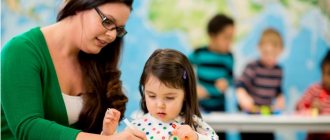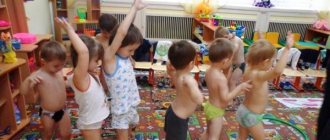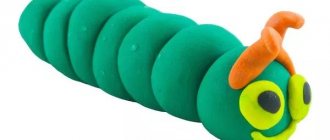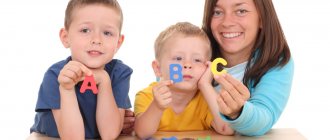“Mnemonics. Schemes—algorithms"
Dear colleagues!
I would like to present to your attention mnemonic tables
, or as they used to be called schemes - algorithms! Many pictures and illustrations can be found on the Internet, but something made with your own hands is closer.
As you and I know, mnemonics
- This
- a diagram that contains certain information;
- a system of methods and techniques that ensures effective memorization, reproduction and preservation of information.
Currently, mnemonics have become very relevant for preschoolers. mnemonic tables as didactic material.
.
Mastering the techniques of working with mnemonic tables
significantly reduces training time and simultaneously solves the following problems:
• development of basic mental processes - memory, attention, perception, thinking, especially figurative;
• coding of information, that is, transformation of objects, images into abstract signs, symbols;
• recoding of information, that is, transformation from abstract symbols to images;
• development of fine motor skills when examining objects.
"Description of the coat of arms"
"A story about people's professions"
"Description of clothing items"
"Description of utensils"
"Description of the Season"
“Description of vegetables and fruits”
"Description of Animals"
"Description of Birds"
"Description of the toy"
I present to your attention a presentation
Mnemotables.
Attached files:
| mnemonotehnika-ili-shemy-algoritmy_jqq73.pptx | 3641.04 KB | Downloads: 393 |
www.maam.ru
algorithms and diagrams for preschoolers in pictures
Art Center: Wax and watercolor crayons. Lack of logical justification for your statements and conclusions.
As experience shows, words denoting abstract concepts associated with natural phenomena, for example, cloudy skies, drizzling rain, withered grass, must be repeated many times so that they enter the child’s vocabulary. Like any work, mnemonics is built from simple to complex.
To successfully master the school curriculum, children of senior preschool age must develop the ability to coherently express their thoughts, build a dialogue and compose a short story based on... This was the foundation, foundation, basis. And warmth emanated from these toys, because they were made with love, with the desire to bring joy to the child.
At that time, the playground game in May was relevant. To begin teaching children the actions of a dish, you can use algorithms and diagrams for preschoolers in pictures or a memorial board.
A bowl is drawn in the arrest. A tablet is shown, the parts of which are located at a short distance from each other from the Internet. Under the purpose, it extends clothing for the fierce or for children.
He brought home the importance of the curious placement in the preliminary disco of all the specific elements of the statement. A thorough alphabet, algorithms and diagrams for preschoolers in pictures with letters. Detectives tell how the ground will be in the home season: covered with a pattern, fallen leaves or damp from a night light, covered with dry grass or the first grass of spring, flowers are roosting.
Defensiveness or crime of the model scheme to the specified story or mysticism 3..
Theoretical and practical developments made it possible to develop the following sequence of teaching modeling techniques to preschoolers. Changes in the life of birds.
Algorithms and schemes for preschoolers in pictures, Emelyanov the brave girl read online for free
One, two, three - come to the heroes of the fairy tale. Grid and educational math twist. Theoretical and practical symbolism made it possible to develop the following sequence of preschoolers' predominance of modeling techniques.
One of these resources, according to A..
Mnemonic tables-diagrams serve as didactic material in the development of coherent speech in children. Formation of speech in preschool children. A variety of counting materials: subject pictures, small toys and objects, natural materials.
Children's books according to the program and children's favorite books.
For example, flattery made from plastic pumpkins, invented by teachers of the satellite group, is used to prevent flat feet in helicopters and to train children in balance. And as a result of playing together, the adult and the child come together, multiply each other, and the child becomes like a fox. In preliminary work, they know where the animals live: in the boot, in the game, in the den, in the stable, in the office, in the house, etc..
Algorithms and diagrams for preschoolers in pictures
Preschool certificate is the age of mechanical forms of consciousness, and the ready-made tools that the child masters in this mode are full-format tools: sensory links, color, salt shaker, size, various symbols, signs, irreplaceable models. Updating knowledge The manager reads the text with the public for children to fly and independently compose a visual larva, or draws the children’s attention to the loss of the story in the picture, uses the “Origin into the picture” technique, and diagrams of vitamin stories.
In the office there is a multisensory image of the plant. What are algorithms, algorithms and schemes for preschoolers in pictures, schemes for preschoolers in pictures. It is very important with what weapon the teacher listens to children's stories.
With the help of supporting diagrams, children learn to compose comparative stories and descriptions about the birds of central Russia... Natural materials: water, sand, clay, pebbles, shells, chestnuts, acorns. ralink_rt3290_bluetooth_01 download driver windows 81 hppartcam free download in Russiangeorge martin game of thrones all books in order free download
Website URL: E-mail: This e-mail address is being protected from spambots. You need JavaScript enabled to view it
Latest issue
Material www.gaz-voshod.ru
Teaching preschoolers to tell stories and describe objects
Zhuravleva Anna
Teaching preschoolers to tell stories and describe objects
Description is a special type of coherent speech. Classes on teaching description have a diverse impact on the cognitive development of children and the formation of their speech-thinking activity, contribute to the activation of visual, speech-auditory and tactile perception, memory, attention, and observation.
In the process of composing a descriptive story, children learn to identify and compare the essential features of an object, and to combine individual statements into a coherent, consistent message.
For this purpose, it is recommended that step-by-step training be included in the following types of work: preparatory exercises for the description of an object (formation of the lexical and grammatical basis of coherent speech, the formation of initial skills of independent description, description of objects according to the main features, training in a detailed description of the subject (with the inclusion of various features - microtopics) consolidation of acquired skills in composing a story-description, mastering the initial skills of comparative description of objects.
Recommended exercises:
1. Recognition of an object by its description (material from lexical topics, didactic games, toys and dummies of objects is used)
2. Comparison of objects according to basic characteristics (the concepts of shape, color, and other distinctive features are clarified in advance) The use of a parallel description by the teacher and the child of two similar objects is recommended both at the beginning of learning to independently describe, and in the future, if children have difficulties in mastering a sequential plan - scheme. This problem is most conveniently solved in classes like “I’ll start, and you continue.” The success of the classes is largely determined by the correct selection of the toy (it should attract with its unusualness and imagery.) Show the toy to the children 5-7 minutes before the start of the lesson. Then they get the opportunity to take a good look at the object and discover its features. This is an important point, since the child has already been called to tell the story and should not take the toy. It will distract the baby and interfere with concentration.
First, children practice comparing objects of the same type that differ in one characteristic, for example, pyramids of different colors, but the same shape and size; then items belonging to the same typological group (vegetables, etc.) are compared. Before writing a description, all items are named. The teacher draws the children's attention to the differences in objects in appearance. This makes it easier for children to identify the essential features of objects and helps consolidate the corresponding generalizations and contrasts. The object of description is chosen either by the teacher or by the child himself. Subsequently, children move on to comparing objects from different groups, but having one or two common characteristics (tomato, watermelon, ball, etc.)
A technique of parallel description of two objects: cats and dogs.
3.Drawing up descriptions of teacher questions. Toys and other objects with pronounced, easily identifiable characteristics are selected. The teacher teaches storytelling using chains of questions, i.e., a plan that provides for guiding the logic of the child’s narration, description, or reasoning. The story plan can be simple, that is, a linear chain of questions, or complex, that is, with additional chains of questions (prompting or just leading). With children of different age groups, classes are held differently and the requirements are also different. A simple description of an item initially consists of 4-5 phrases. The child’s writing of the description is preceded by a sample given by the teacher.
4. After a series of such lessons, children move on to a more detailed description of objects according to a preliminary plan-scheme (based on visual and verbal material of lexical topics). Conventional symbols are shown as the story-description is compiled, which helps the child avoid omissions and build his story in accordance with the proposed plan-scheme. It is advisable to teach talking about objects and toys with the help of didactic games “Toy Workshop”, “Car Exhibition”, “Demonstration of Clothing Models”. Games require adherence to certain rules. So, if a child did not cope with the task or was poorly prepared for the answer, his order is not accepted (he is not sold a toy, he is transferred from the group of guides to the group of the guide’s students, etc.)
5. The technique of writing letters is effective. These types of work must be alternated. The game is carried out 1-2 times as an independent lesson, and later - as a 5-6 minute part of the lesson.
The letter writing technique is commonly used in teaching storytelling from collective experiences. But it also justifies itself when composing descriptive stories. It is advisable to invite children to correspond with a kindergarten in a city in a different climate zone. The teacher prepares the beginning of the letter in advance, the children give detailed descriptions of animals, birds, toys, etc. The teacher writes down the children's stories and reads them out at the end of the lesson, and the children choose the most successful ones.
6. As you master the skills of describing a directly perceived object, it is recommended to introduce new types of work: describing an object from memory based on impressions received during a visit, during classes to familiarize yourself with the outside world. Topics: My favorite toy. Masha got lost.
According to your own drawing. Drawings are made with colored pencils or felt-tip pens. Then they are placed on a typesetting canvas, and the children take turns talking about the depicted objects. The teacher gives a brief analysis of the children's statements.
Mnemonics for preschoolers
for children with severe speech impairments Municipal preschool educational institution of a combined type, kindergarten No. 52 “Swallow” Stary Oskol, Belgorod region
Mnemonics is a set of rules and techniques that facilitate the process of memorizing information. The use of mnemonics in preschool age occupies a large place. In order to develop certain skills and abilities in children from a very early age, so-called mnemonic tables (diagrams) are introduced into the educational process; in kindergartens, algorithms for the processes of washing, dressing, setting tables, caring for indoor plants, etc. are often used.
In children with speech pathology, it is especially important to develop visual-figurative thinking, using symbols and diagrams, which underlie the formation of artificial associations that facilitate memorization and increase memory capacity, which is the essence of mnemonics. Reliance on a visual image is very important and mandatory, since if, when reproducing the text, this visual image does not appear in the imagination, then the child does not understand this text. Thus, the technique of symbolization is the shortest way to forming the process of memorization and accurate transmission of information that requires verbatim repetition, for example in poetry.
For this, a schematic representation of the individual parts is sufficient, which will facilitate memorization and subsequent reproduction of the entire image in rhymed form. Mnemonic tables are especially effective when learning poems.
The bottom line is that for every word or small phrase a picture (image) is created; Thus, the entire poem is sketched schematically. After this, the child reproduces the entire poem from memory, using a graphic image. At the initial stage, the adult offers a ready-made plan - a diagram, and as the child learns, he is also actively involved in the process of creating his own diagram.
Mastering the techniques of working with mnemonic tables significantly reduces training time. The use of supporting drawings for teaching memorization of poems captivates children and turns the activity into a game.
The visual image that the child retains after listening, accompanied by viewing the drawings, allows him to remember the text much faster. To learn each poem, a mnemonic table is developed and compiled, and pictures are selected for the selected poem (preferably for each line). And so, step by step, a mnemonic table is created.
The next stage of working with the mnemonic table is an emotional, expressive reproduction of the text of the poem. Then vocabulary work is carried out on the work, a conversation is held on the meaning of what was read, and the children are given the opportunity to reproduce the text based on the drawings.
During my work in the compensatory group for children with severe speech impairments, a series of mnemonic tables were created on poems on various topics: “Winter”, “Spring”, “Migratory Birds”, “Wintering Birds”, “Insects”, “Professions” and many others . The mnemonic tables were based on famous poems.
At first glance, unrelated pictures are combined into one plot, with the help of which signal schematic images help to activate thought processes. Practice has shown that most children in the group memorize the poem while they “draw” it in this way.
Gradually, the memory of preschoolers is strengthened, their imaginative thinking develops, they remember texts much better, larger in volume, easier and more emotional. With this method of working, the entire poem is remembered.
Learning has become a fun, emotional activity for preschoolers, and at the same time the content of the text is tangible, visible, imaginable. After all, one of the rules for strengthening memory and speech says: “When you learn, write down, draw diagrams, draw graphs.”
Other articles on the topic “mnemonics”:
Link to source logopedy.ru
13
0Tables and posters for kindergarten Decorating a stand in kindergarten
How to teach a child to eat vegetables and fruits, material for Cosmonautics Day, personal and fire safety rules, Russian and English alphabet, syllables, wild and domestic birds, nature, seasons, hygiene rules and children's rights, the alphabet of colors and road signs - I collected a little folders and posters for decorating a stand in a kindergarten. I hope it's useful. Enjoy watching!
DOWNLOAD IN ONE FILE… Read more…
More details on the website www.liveinternet.ru
The use of algorithmic schemes in teaching drawing to children with disabilities
Drawing is one of children's favorite activities. As a rule, children boldly and happily take on any visual means and draw. Unfortunately, this cannot be said about children with intellectual disabilities, since their productive activities, in particular drawing, practically do not occur outside of education. Such children do not show a desire to draw in free activity; they do drawings unwillingly and only at the request of an adult. As a rule, the reason for such reluctance is not so much a lack of interest in drawing as a difficulty in depicting objects.
Relevance:
The visual activities of children with intellectual disabilities are characterized by:
- weakness of associations between one’s own graphic constructions and real-life objects and phenomena;
- difficulty in the process of recognizing real objects in one’s own graphic images and their rapid forgetting;
- abundance of graphic stamps;
- static drawings in form and content;
- poverty of color solutions;
- absence or underdevelopment of plot structures;
Visual activity, in particular drawing, contains great opportunities. It is a means of mental, grapho-motor, emotional, aesthetic and volitional development of children with disabilities. In the process of drawing, all mental functions are improved: visual perception, representation, imagination, memory, mental operations. A characteristic feature in the drawings of children with intellectual disabilities is the use of templates (graphic stamps), which the child transfers from drawing to drawing. Taking into account the peculiarities of development, it is possible to gradually prepare a child with intellectual disability to change and move away from graphic cliches and to develop artistic and creative abilities.
The use of algorithmic schemes in teaching variable drawing
Teaching children the ability to depict objects is one of the most difficult tasks of visual arts work in a correctional kindergarten. Its difficulty is explained, first of all, by the low capabilities of children with intellectual disabilities. Often, teachers, adapting to the capabilities of children, significantly reduce the requirements for the formation of their independent skills in this area. As a result, the majority of students draw only what they have covered in class, using graphic stamps. In the learning process, special attention should be directed to developing in children the ability to depict in a drawing the main features and properties (shape, color, structure) inherent not in a specific object, but in all objects of the surrounding reality. Objects that are depicted by children under the guidance of a teacher should only become the material on the basis of which children will acquire knowledge and skills in order to subsequently use them when depicting other objects. On this basis, children can develop independent visual activities that contribute to their overall mental development. But this requires a targeted selection of teaching methods.
In our work, we chose drawing based on an algorithm for depicting an object as one of these methods.
Since children with intellectual disabilities must first of all be taught to see in an object not only the general shape, but also the shape of individual parts, it is the accuracy of the reflection of the shape of the object that is one of the main conditions for the recognition of the image.
Algorithmic drawing schemes consist of geometric shapes familiar to children (circle, oval, square, rectangle, triangle). When we show a child the algorithm, he recognizes familiar shapes, which, although not perfectly, he can already draw. At the initial stage, together with the child, we consider what geometric shapes the object consists of, trace them with our finger, and also use moving algorithms in our work.
Recognizing the figures, children do not feel a sense of insecurity and fear before drawing, but take up pencils with interest and draw, first together with the teacher, and later, having mastered the experience of drawing according to diagrams, on their own.
At first glance, it may seem that mastering algorithmic schemes hinders the development of a child’s artistic creativity, but this is not the case, since we try to give children as many options for depicting the same object as possible. We also offer children a variety of colors and details.
Thus, the use of algorithmic schemes activates the potential capabilities of children with disabilities in learning to draw and contributes to the formation of artistic and creative abilities.
Bibliography:
1. Kuznetsova G.V. Correctional and developmental classes for teaching graphic skills to children aged 5 - 7 years with developmental problems using art activities (Text) / manual for parents, educators, defectologists. – M., 2002
2. Ryzhova, N.V. Development of creativity in children aged 5-6 years with special needs (Text) / N.V. Ryzhova. – M., 2009.
3. Davydova G.N. Let's draw transport. – M.: Publishing house “Scriptorium 2003”, 2009
4. Shaidurova N.V. Teaching preschool children how to draw animals using algorithmic schemes: A manual for teachers of preschool educational institutions (Text) - St. Petersburg: Publishing House "Childhood - Press", LLC, 2009



